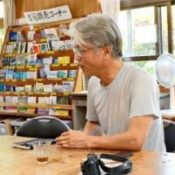
June 30, 2016 Ryukyu Shimpo
By Hiroe Nakagawa
On June 17, Kazuyuki Sasaki, who teaches Peace Studies at a university in the Republic of Rwanda, located in central Africa, and his wife Megumi visited the “Wabiai no Sato” foundation in Ie Village. They had a conversation with the foundation director Etsuko Jahana who shares the way of life and philosophy of the late Shoko Ahagon, the father of the Okinawan civil rights movement who devoted his life to the peace movement and fought non-violently and reasonably. Tracing the trajectory of Ahagon, Sasaki will introduce the story of Ahagon in his class.
Sasaki has lived in Rwanda for eleven years. He did research through a graduate program in England on peacebuilding. He has engaged in supporting reconciliation between perpetrators and victims who still suffer from the Rwanda genocide of 1994. Currently, he works as the head of the Department of Peace and Conflict Studies at the Protestant Institute of Arts and Social Science in Rwanda and gives lectures on the theme of “non-violence theories and practices.”
In his lectures, Sasaki refers to Ahagon in addition to the world’s great peace figures such as Gandhi and Martin Luther King. Sasaki visited “Wabiai no Sato” to learn about Ahagon’s personality and ways of life, which he said he could not grasp only from reading books.
Jahana described Ahagon as “conservative and committed while not being negative or a follower. He fought non-violently without using any abusing words or violence until the end. I think his principle won. He kept saying, ‘The weapon of peace is learning,’ and he studied hard. He was humorous.”
Sasaki said, “In Rwanda, perpetrators, who engaged in the genocide, got back into society and rejoined in the same village. The challenge is reconciliation and harmonious coexistence of both. I have a student, who suffered the loss of their father during the genocide. I would like to teach Ahagon’s ways of life and lessons for peacebuilding.”
(English translation by T&CT and Megumi Chibana)
Go to Japanese
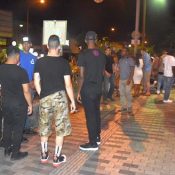
July 3, 2016 Ryukyu Shimpo
July 2 was the first weekend after the end of a period of mourning imposed on U.S. forces in Okinawa following the suspected rape and murder of a woman by a U.S. military contract employee who is a former U.S. marine. During the period of mourning U.S. forces banned its personnel from drinking alcohol and going outside of the bases. The day the ban was lifted, many soldiers flocked into Gate 2 Street in Okinawa City in front of Kadena Air Base.
Some soldiers mourned the death of the woman, saying regretfully, that no one can not take her back. Most soldiers welcomed the lift of the ban.
A woman who works at a bar along the street said, “The number of customers connected to the U.S. military has been increasing a little bit. Not all of them are bad people. It is not right that one criminal case has become a controversial issue concerning all the U.S. bases.” One restaurant owner said, “We welcome the lift of the ban on drinking alcohol.”
“Honestly, I don’t want U.S. soldiers to come out to the streets. I think it is better to have no U.S. bases. But, Koza (current Okinawa City) has long been in coexistence with the bases,” one passerby said.
“I was born here, and has chosen to live here. Recently I have begun to think about a less complicated way to view the situation.”
Some soldiers and civilian personnel declined to answer questions from the reporter. However, some expressed their mourning for the victim.
A 21-year-old soldier, who was assigned to Camp Hansen about a month ago, welcomed the lift of the ban and spoke frankly. “A foolish man committed a crime,” he said, “We must be careful of our own behavior. If someone commits such crime, all the service members will have to receive the same punishment.”
(English translation by T&CT)
Go to Japanese
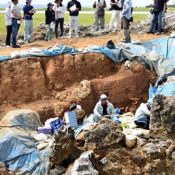
July 1, 2016 Ryukyu Shimpo
By Gaisho Yonekura
On June 30 the Okinawa Prefectural Buried Cultural Property Center announced to concerned persons its latest excavation discovery of a 21,000 year-old full-body human skeleton at Shiraho Saonetabaru Cave Ruins. This skeleton is the oldest full skeleton discovered in East Asia, even older than the skeletons of the Minatogawa people (from about 18,000 years ago) of the Paleolithic Era discovered in Yaese Town. About 1,000 pieces of bone that appear to make up about ten body parts have been found during investigation of the cave ruins since 2010. These ruins are the largest scale from their time period within Asia. An information session was conducted on July 1 for concerned persons, and on July 2 another was held for the general public.
The cave ruins are located on the grounds of the Shin-Ishigaki Airport, and were detected due to a survey of the land prior to construction. Once the site was detected, it was decided that the excavation would take place over ten years of the site being preserved, with a 5-year investigation plan starting in 2012. Parts of this full skeleton were discovered last year, and finally the remaining parts of the spine have been found and are to be completely exhumed and examined by July 2. The discussion will start next year on whether to continue to preserve the site or put it to use.
![(Top left) thoracic vertebrae and (top right) forearm bone (Bottom left) clear rendering of top photograph (Bottom right) map showing positioning of Shiraho Saonetabaru Cave Ruins [black dot] and Shin-Ishigaki Airport [grey shape]](http://english.ryukyushimpo.jp/wp-content/uploads/2016/07/遺跡図面.jpg)
(Top left) thoracic vertebrae and (top right) forearm bone
(Bottom left) clear rendering of top photograph
(Bottom right) map showing positioning of Shiraho Saonetabaru Cave Ruins [black dot] and Shin-Ishigaki Airport [grey shape]
Archaeological excavation at the cave ruins has found a large quantity of human bones from about 20,000 years ago, but no man-made tools or artifacts have been unearthed yet. Some researchers think that this site was a graveyard, since the human bones have been found concentrated in four spots. If people from that time period are found to have prepared gravesites separate from where they carried out their daily activities, it will be a globally recognized discovery. To see what conclusions come of this discovery, keep an eye out for the report that will come available at the end of this year.
(English translation by T&CT and Erin Jones)
Go to Japanese

July 1, 2016 Ryukyu Shimpo
On June 30, the Naha District Public Prosecutors Office brought additional charges of murder and rape leading to death against U.S. military contractor Kenneth Franklin Shinzato (formerly Gadson), 32, of Yonabaru Town, on the grounds that he assaulted a woman with the aim of raping her, and then murdered her. The defendant had previously been indicted on June 9 on the charge of abandoning the woman’s body in the central part of Okinawa Island. The trial will be a public trial with a jury. The Prosecutors Office has not revealed whether the defendant will plead innocent or guilty.
According to the written indictment, around 10 p.m. on April 28, the defendant assaulted a woman going for a walk in Uruma City with the intention of raping her, hit her on the head with a blow bar, then tied her hands and neck and stabbed her several times in the neck with a knife. He then attempted to rape her but failed. In the process, the woman died.
The Prosecutors Office is charging the defendant with murder and rape leading to murder, based on its recognition that the defendant attacked the woman with the aim of raping her, and that his actions were carried out with murderous intent. It has revealed neither specific details of the weapons used, nor whether the weapons have been found.
Regarding the defendant’s indictment for the two crimes, his lawyer, Toshimitsu Takaesu, has not revealed any details of the defendant’s testimony or plea, saying, “I have not seen the written indictment, and have no comment to make at the present moment.” He said that going forward he will confirm the written indictment and the evidence with the defendant, and discuss with him how to proceed.
The defendant was initially arrested on suspicion of having abandoned the woman’s body in the northern part of Okinawa Island, and was officially charged on June 9. On the same day, the prefectural police re-arrested him on suspicion of raping and murdering the woman. Before being arrested on suspicion of abandoning the woman’s body, the defendant had testified in response to police questioning that he had attacked her for the purpose of raping her, and stabbed her with a knife.
According to investigators, the defendant hinted from the start that he had murdered the woman, and testified that he had hit her with a 30-40 centimeter self-defense stick. A stick matching his description was found in a canal in Uruma City. Since May 20, the defendant has maintained silence, and the knife he used has not yet been found.
In response to the incident, a mass rally was held on June 19 in Naha City at which 65,000 people (according to organizer estimates) gathered to demand the withdrawal of the U.S. Marines from Okinawa. The U.S. military announced a period of mourning to last until June 28 during which military personnel would not be allowed to consume alcohol off base, but during that period, two U.S. Marines were arrested on suspicion of drunk driving.
(English translation by T&CT and Sandi Aritza)
Go to Japanese
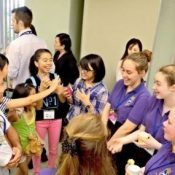
June 29, 2016 Ryukyu Shimpo
A reception ceremony was held for seven students and two teachers from Dene Magna School in England at Chatan Nirai Center in the Kuwae district of Chatan on June 25. They visited Okinawa as part of an exchange project between Chatan and the United Kingdom. About 40 host family members took part in the event, deepening the exchange. The students are scheduled to stay in Okinawa until June 30, visiting tourist spots such as Shurijo Castle. They will also attend classes in local schools to learn tea ceremony and eisa dance.
The project started in the wake of Prime Minister of the United Kingdom Tony Blair’s visit to Chatan during the Okinawa summit held in 2001. This is the third time the project has been carried out. The history of the relationship between Chatan and the United Kingdom goes back an incident in which sailors aboard the British ship Indian Oak were shipwrecked off the coast of Chatan and cared for by local people in 1840. Will Collard from Dene Magna School will be hosted by Seishu Gishi from Chatan Junior high School. Gishi said, “I feel nervous. I will enjoy the time and want to bring him to a sushi restaurant.” Collard said that he was excited.
Chatan Mayor Masaharu Noguni said, “I would like British students to exchange with Chatan students and learn the history and culture of the town.” Chatan school superintendent Keiichi Kawakami delivered a speech in English, telling foreigners to have the great time.
(English translation by T&CT)
Go to Japanese
June 28, 2016 Ryukyu Shimpo
The Okinawa Prefectural Government announced on June
27 that Okinawa’s tourism revenue for 2015 was 602,214,000,000 yen. This is a 12.7 percent increase from the year before, the highest annual revenue to date for the third year in a row, and the first time that the annual revenue has reached the 600 billion yen mark. The drastic rise in numbers of foreign tourists has boosted revenue overall. Tourists spent 75,881 yen per capita, 1.9 percent more than in the previous year. Per capita expenditure by tourists reached a record high in 2006 and has increased each year since.
In 2015, domestic tourists’ expenditure per capita rose  from the previous year by 2 percent to 74,083 yen. Foreign tourists who came by plane spent 107,302 yen per capita, a 12 percent increase, while foreign tourists who came by boat spent 25,973 yen per capita, a 2.9 percent increase.
from the previous year by 2 percent to 74,083 yen. Foreign tourists who came by plane spent 107,302 yen per capita, a 12 percent increase, while foreign tourists who came by boat spent 25,973 yen per capita, a 2.9 percent increase.
A breakdown of per capita expenditure shows that in 2015 lodging expenses accounted for about 30 percent of a tourist’s spending on a trip at 23,217 yen, a 4 percent increase from the previous year; souvenir and shopping expenses accounted for 17,149 yen, a 4.7 percent increase; and amusement including park entry fees accounted for 6989 yen, a 5.8 percent increase.
The average length of a tourist’s stay in Okinawa has decreased to 3.83 days. This is shorter stay by a one-hundredth of a day compared to 2014.
(English translation by T&CT and Erin Jones)
Go to Japanese
June 28, 2016 Ryukyu Shimpo
On May 27, it was discovered that the U.S. Marine Corps refused a request by the Okinawa Prefectural Board of Education to conduct surveys at three sites within U.S. Marine Corps Air Station Futenma as part of an excavation project being carried out inside the base. The excavation project aims to recover buried cultural artifacts, and is overseen by the Okinawa Prefectural Board of Education and the Ginowan Municipal Board of Education. The Okinawa Prefectural Board of Education made the request to excavate the three sites in fiscal 2015, and in November of last year, the Marine Corps denied the request, demanding that the prefecture submit any request on the basis of the Supplementary Environmental Agreement, an agreement between Japan and the United States that supplements the Status of Forces Agreement. However, at the request of the Okinawa Defense Bureau, the Ginowan Municipal Board of Education has been conducting its own cultural artifact survey within the base in preparation for the relocation of a U.S. military road that is needed due to construction of a new municipal road 11. It appears the U.S. is handling the two cases differently, revealing the fact that whether or not surveys can be conducted on base is entirely up to U.S. discretion.
The Supplementary Environmental Agreement stipulates that Japanese authorities are allowed to conduct environmental surveys and surveys of cultural artifacts on U.S. base land before it is returned to Japan. The Agreement was concluded in September 2015 between the Japanese and U.S. governments with the pretext that it would increase the Japanese government’s authority to conduct environmental surveys on U.S. bases.
The Prefectural Board of Education believes its request was denied due to wording in the Agreement stipulating that surveys may be conducted no more than seven months before the scheduled return date of the land. The Board plans to ask the Japanese government for permission to conduct its survey within the base, since Futenma will not be returned for at least seven to eight years, at which point it may be too late to conduct the survey.
The Prefectural Board of Education submitted a request to the U.S. Marine Corps in fiscal 2015 to survey three sites to the north of Futenma’s runways: the fifth and third Kiyuna Maehara sites, and the third Kiyuna Higashihara site.
Since the Board received no reply to its request until November of last year, it made an inquiry to the U.S. Marine Corps, which in turn sent a notification that the Supplementary Agreement would apply to all future cases.
On June 27, in response to an inquiry by the Ryukyu Shimpo, the U.S. Marine Corps replied that it was confirming the information and would respond as soon as possible.
Meanwhile, there are plans for Ginowan’s municipal road 11 to pass through the approximately four acres of land on the west side of Futenma that the Japanese and U.S. governments have announced will be returned within the year 2017.
The Okinawa Defense Bureau is working on relocating a U.S. military road and fence located within the land set to be returned. The Ginowan Municipal Board of Education is carrying out a survey of cultural artifacts in this area at the request of the Okinawa Defense Bureau.
The survey to be conducted by the Prefectural Board of Education aims to survey cultural artifacts and is funded by a budget from the central government’s Agency for Cultural Affairs. Meanwhile, the work relating to the construction of municipal road 11 is funded by a budget that comes from the Ministry of Defense.
(English translation by T&CT and Sandi Aritza)
Go to Japanese
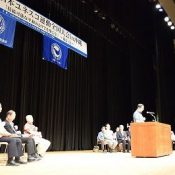
June 25, 2016 Ryukyu Shimpo
Japan’s National Federation of UNESCO Associations opened its 72nd convention on June 25 at the Okinawa Convention Center in Ginowan City. The convention was held for the first time in 34 years, the last being in 1982.
About 500 members from UNESCO associations in Japan took part in the convention.
Through a special lecture and panel discussion, participants approached the issue of building peace from the perspective of the theme of the convention titled, “Nuchidutakara- Let’s build a fortress for sustainable peace”.
It was held on June 26.
Yoshikazu Higashi, chair of the Okinawa UNESCO Association, said at the opening ceremony, “In this convention, we would like to think about the peace issue squarely. We need to nip the cause of confrontation in the bud. I believe the UNESCO Associations’ pigeon, the symbol of the world peace, is stronger than a hawk.”
(English translation by T&CT)
Go to Japanese
Panelists including people who experienced the war share ideas at the UNESCO associations’ national convention
June 26, 2016 Ryukyu Shimpo
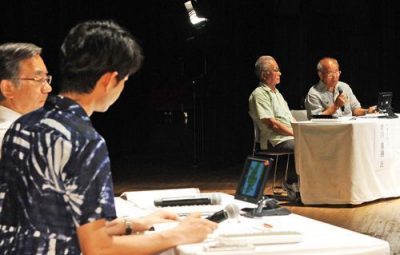
Panelists stressed the importance of survivors continuing to talk about their experiences during the Battle of Okinawa at a discussion held on June 25 at Okinawa Convention Center, Ginowan City.
Tetsuya Takahashi, a professor of philosophy at the Graduate School of Arts and Sciences in the University of Tokyo, delivered a special lecture. Takahashi said, referring to the current situation in Okinawa, where U.S military bases in Japan are concentrated, “This is discrimination against Okinawa by Japan’s mainland.” He brought up the issue of mainlanders’ responsibility, saying, “The Japan-U.S. security system is supported by a massive majority of voters. If the voters who live in the mainland want to maintain the security system, they must bear more of the burden and risks stemming from U.S. bases, in the places where they live – such is their responsibility for their political decision to accept the system.”
Yoshikatsu Yoshikawa, a former chairman of the Education Committee of Tokashiki Village, and Fujiroku Oshiro, a former school superintendent in Itoman City, took part in the panel discussion.
Yoshikawa is a survivor from a “mass suicide” that took place in Tokashiki Island during the Battle of Okinawa. He said, “The troops came to the island, and ‘the mass suicide’ was triggered. Nothing like that happened in the places where the Japanese army was not stationed.” He added, “I would like you to think about how to build a peaceful Japan in the future through the facts.” Oshiro experienced being forced out of a shelter cave during the war. He said, “The lesson that I learned from the Battle of the Okinawa is that Japanese soldiers did not defend the residents.”
Yoshimi Kosaki, a company employee from Ehime Prefecture who sat in on the panel discussion, said, “I feel strongly that it is important to hear tragic war stories directly from people who experienced the battle of Okinawa. Works to preserve the war monuments and the testimonies of those who experienced the war are very important if we are to prevent the war memories from wearing thin with time.”
(English translation by T&CT)
Go to Japanese
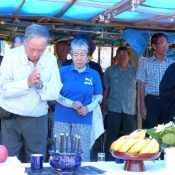
June 23, 2016 Ryukyu Shimpo
A memorial service for people who died in the Ourasaki internment camp right after the Battle of Okinawa was held in front of the gate of Camp Schwab, the US military base in Henoko, Nago City on June 23. The internment camp was located in Camp Schwab.
Approximately 100 citizens who are participating in the sit-in protest offered incense and prayed for the victims at an altar set up at the sit-in tent in front of the gate.
The memorial service was held for the first time last year. Representative of volunteer group Gamafuya, which retrieves the remains of the war dead, Takamatsu Gushiken, explained that residents of Motobu Peninsula and Ie Village were contained at the Ourasaki internment camp area and many of them died because of malaria and starvation between June and October of 1945. According to documents Gushiken gathered from the prefectural government, 304 people have been reported as dead in “Ourasaki” or “Oura” by bereaved families. However, it is believed more people have actually died in Ourasaki.
Gushiken stressed, “The residents were shut off from the area due to construction of the base soon after the war in 1957. It is highly likely that many remains are still left untouched. I would like to directly negotiate with the US military about entering the area to collect the remains.”
The participants at the sit-in put their hands together and prayed for the war victims including those whose remains are not yet to be retrieved.
Seventy-four-year old Yoshiyasu Iha, who is a representative of “Okuma River Basin Protection Foundation” and who also planned the event emphasized, “It is disrespectful to the victims that the governments of Japan and the United States would construct and keep the bases at a place where many bones might still remain today.”
(English translation by T&CT and Sayaka Sakuma)
Go to Japanese
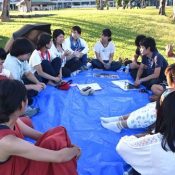
June 24, 2016 Ryukyu Shimpo
On June 23 at the Peace Memorial Park in Mabuni, Itoman City, the “Hiroshima, Nagasaki, Okinawa Wakamun Conference 2016” was held. The participants were young people who act as peace guides in the three prefectures that had tremendous damage during World War II. Reflecting on existing peace education, 12 participants shared their thoughts on how to “expand activities of positive peace and think about peace constructively.” The organizer is venture company Gachiyun launched by students from the University of the Ryukyus.
A lady from Yokohama said that she does not remember having peace education in her hometown. She said, “I feel envy that Okinawa, Hiroshima, and Nagasaki have many chances to learn about war.” Also, another lady said, “People become removed from peace education after finishing school. It may be better to have an environment to think about it on a long-term basis.”
President of Gachiyun Shun Kuninaka said, “It is important to listen to the valuable stories of war experiences. However, we should think about how we can connect it to the peaceful future. I hope to look for peace education that people can feel in their heart.”
(English translation by T&CT and Megumi Chibana)
Go to Japanese



![(Top left) thoracic vertebrae and (top right) forearm bone (Bottom left) clear rendering of top photograph (Bottom right) map showing positioning of Shiraho Saonetabaru Cave Ruins [black dot] and Shin-Ishigaki Airport [grey shape]](http://english.ryukyushimpo.jp/wp-content/uploads/2016/07/遺跡図面.jpg)



 from the previous year by 2 percent to 74,083 yen. Foreign tourists who came by plane spent 107,302 yen per capita, a 12 percent increase, while foreign tourists who came by boat spent 25,973 yen per capita, a 2.9 percent increase.
from the previous year by 2 percent to 74,083 yen. Foreign tourists who came by plane spent 107,302 yen per capita, a 12 percent increase, while foreign tourists who came by boat spent 25,973 yen per capita, a 2.9 percent increase.



 Webcam(Kokusai Street)
Webcam(Kokusai Street)


